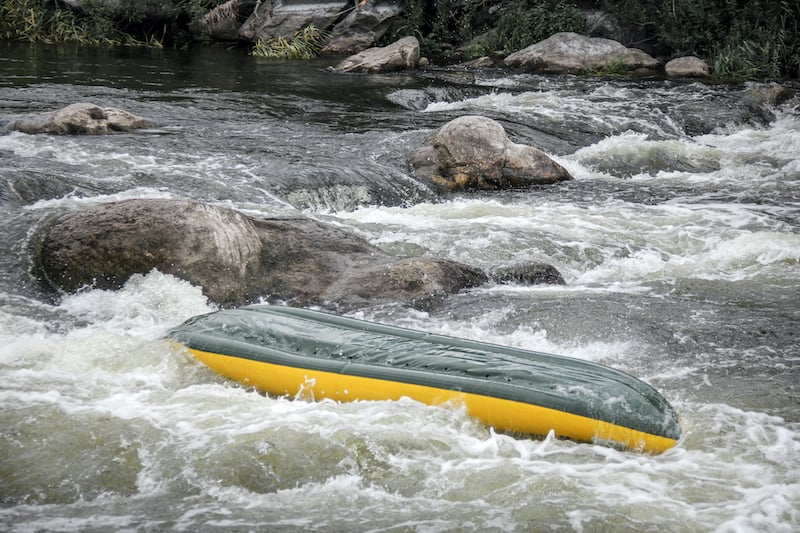The short answer to this question is no; kayaks do not tip over easily. But like many things, it can depend on several factors. Some kayak designs are much tippier than others. The conditions of the water and the weather can also play a factor.
For example, a long and narrow racing kayak can be extremely tippy. It might not be very noticeable on calm water, but when paddling with large waves, it might quickly become unmanageable. Likewise, a short and small whitewater kayak is very agile and maneuverable. It’s designed to handle choppy waves and eddies, but it requires quick paddle work to keep it upright.
Of course, most new paddlers aren’t in a top inflatable kayak. They’re most often sitting in a beamy recreational craft that is extremely stable. Sure, you can fall off or tip over if you try to stand up or lean over too far, but it’s highly unlikely.
What Causes Kayaks to Tip Over?

Sitting in a kayak is a bit like riding a bicycle. When you first start, and you aren’t very good at it. It’s quite intimidating. But once you’ve done it once, you’ve got it.
By the time you’ve got a few hours of paddling under your belt, you won’t give tipping over another thought. Like all activities, the more you know, the more confident you will become. Everyone is nervous at first, but the fun of the adventure quickly pushes those thoughts aside.
Kayaks will tip over for one of two reasons. Either the paddler lost their balance, or they were flipped by an external force that the paddler didn’t see coming. Just like riding a bike, even if you start to lose your balance, you can often take corrective actions to remain upright. One of the benefits of a hardshell kayak vs an inflatable kayak is that you can practice flipping so that you’re prepared for it when it does eventually happen.
How Do You Balance When in a Kayak?

The first step to balancing your paddle craft is to distribute all of your stuff evenly. If the kayak isn’t sitting level before you get in, you’re going to have trouble for the rest of the trip. Make sure that the boat is sitting level fore to aft and side to side. Don’t put all of your gear in the back or front because this will not only reduce the stability but also reduce the performance.
Once you’re in the kayak, it should sit level on its own. It should move freely as you move your body, but typical body motions shouldn’t affect your balance significantly. The lower you sit in the kayak, the more stable it should be. For example something like the
How to Prevent Your Kayak From Tipping
The biggest thing that you can do to prevent tipping over is to practice. If you’ve got a calm body of water and you don’t mind going for a swim, just get it over with. Tip yourself out and try to get back in. You’ll learn a lot, like exactly how far over you have to go to capsize and how hard it is to get back in. Obviously, only do this when it’s safe to do so, with help and solid land nearby.
Practice Risk Management
Like any water activity, the weather and water conditions dictate where you should go and when. It’s up to the paddler to pick their weather and to realize when conditions are too challenging for them. New paddlers should be more conservative and should avoid strong winds, currents, or big waves.
Risk management in kayaks also goes beyond just the weather. You should pick the right size and type of kayak for the paddling you are doing, and make sure it’s balanced for the conditions. Don’t overload it.
When out on the water, you also want to keep an eye out for things that might spell trouble, like a yacht throwing a big wake or breaking waves. You can’t avoid everything, but the sooner you see it, the quicker you’ll be able to prepare for it and react accordingly.
If you’re faced with a big wave or boat wake that you think might flip you over, turn your boat into the wave and paddle into it. Taking the wave head-on may result in burying the bow and getting wet, but taking it on the beam could tip you into the drink. The best thing to do is to take the wave at a 45-degree angle.
Brace Strokes
Not every paddle stroke is used solely to propel the boat forward. You can use your paddle blade to do all sorts of things, including helping you stay upright. A brace is a stroke used to push at the surface of the water and give you a little bit of support. Instead of pulling the boat through the water as you usually do, you are pushing down to move more upright.
The two main braces that you should practice are the low brace and the high brace. During the low brace, the paddle is held at waist level. The high brace is similar, but the paddle is held higher, near your shoulders. The high brace results in a more powerful stroke, which is handy if the boat has tipped and you’ve almost gone over. In contrast, the low brace is an everyday maneuver that you can do to aid your balance a little.
Braces are helpful maneuvers that you should practice, but many people successfully kayak for years without doing either. If you’re brand new to it, a beamy sit-on-top beach kayak provides all of the stability that anyone needs. If you are paddling a tippier performance craft, then braces become far more critical.
What Do You Do If You Flip Over?

In most situations, the easiest thing to do if you’ve fallen off the kayak is to simply get back on. Sometimes that’s easier said than done, though especially if you’re in an inflatable kayak like the Sevylor K5 Quikpak.
For one thing, you’ll need to get the kayak upright again. After you’ve righted it, you need to climb aboard. This is a lot easier if you’ve got your PFD on, which you were wearing, right?
If you’re paddling with another kayaker, they can assist you in getting back in the boat by helping to stabilize your kayak while you get in. The tricky thing is to keep your boat level. Another critical tool to have onboard is a paddle float. This simple device is just an airbag that slips over one blade of your paddle. With it, you can make your paddle into an outrigger, which will keep your vessel upright to help you get in.
Getting back in the boat from deep water isn’t easy, and it’s seldom a graceful maneuver. It’s beneficial to practice in a pool or some other protected body of water if you can. This will give you the confidence to tackle the challenge should you ever find yourself taking an unexpected swim.
Some sit-in kayaks with spray skirts can be rolled right with a maneuver called the Eskimo roll. This is an advanced maneuver that requires some practice, and it doesn’t always work. Every paddler should be ready to swim out and get back in their boat.
Conclusion
Tipping over in a kayak is one of those “what-if” questions that many new paddlers worry about before starting, but it isn’t something that anyone should lose sleep over. Kayaks are incredibly stable vessels, and tipping over or falling off is extremely unlikely.
We recommend falling in on purpose and learning to capsize your kayak intentionally to practice what you’ll do in calm water. That way, if you do fall in when you weren’t intending to you’re prepared and know what to do.
